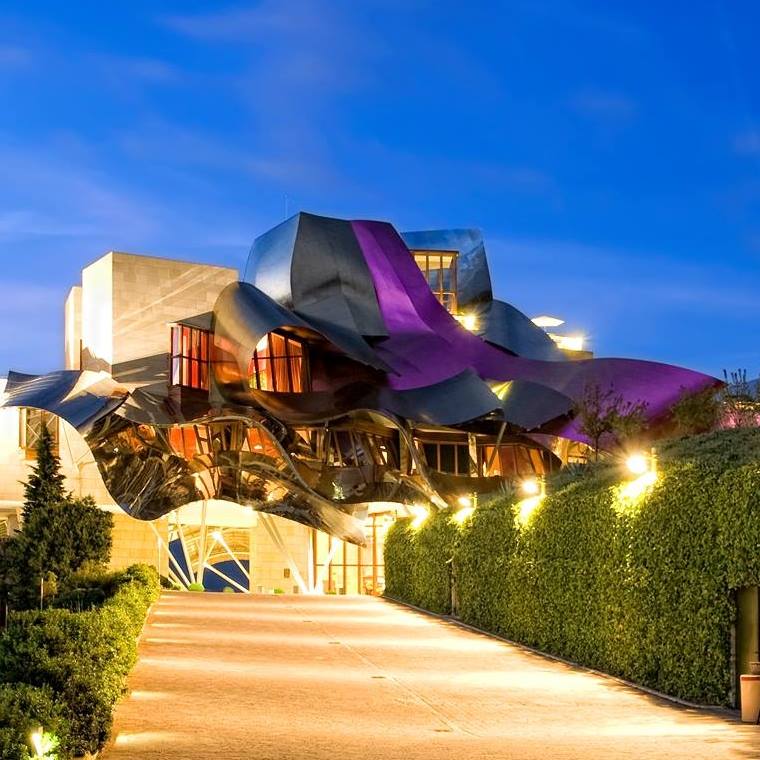Join us in this tour around one of the most famous wineries in Spain, and perhaps the one to visit if you are heading to Rioja region.
When we pass the Ebro, already an hour and twenty right into the trip, the dark asphalt reveals that we are once again entering the Basque Country. After 2 or 3 kilometers we arrive in Elciego and also as the vehicle turns the corner we see a type of beaming flying dish among the wineries and 19th-century buildings.
The ex-libris of our visit is a building appointed by the Herederos de Marqués de Riscal to the Canadian engineer Frank O. Gehry. The structure by the author of the Guggenheim in Bilbao, which stands apart for its advanced contorted panels in titanium as well as steel, was erected as a rite of passage in between the past and the future. Developed in 2000 and also inaugurated in 2006, the City of Wine incorporates the original buildings, consisting of a winery geared up with innovative innovation, a shop, and a luxury hotel, which additionally includes a Michelin-starred dining establishment (by Chef Francis Paniego) and also a vinotherapy health facility.

Although it looks like an odd body, the advanced structure appears well incorporated as well as the choices of shades and also some products have significance. As an example, the built component, built in rock of the conventional sandstone of the area (sedimentary rock), faces the town of Elciego et cetera faces the wineries, and the coloring of the steel and also titanium plates stand for the shades of the brand name: pink – the grapes as well as the wine; gold – the cable that borders the bottles; and silver grey – the bottle capsule.
After visiting the “international body” we proceed to the original vineyard buildings, very carefully restored in order to preserve the initial attributes, and where the set of fermentation storage tanks in “Allier” oak stand out.
The original winery was finished in 1868 and was just one of the very first to be constructed in every one of Rioja by a leading producer. A couple of years previously, the fantastic change had actually begun in the area with the arrival of French vendors and also specialists, that came in search of a new source of supply after phylloxera had annihilated the vineyards in France from the late 1840s. Rioja had a practice of a glass of wine production, yet was significantly tailored to the local market and also much less established than Bordeaux, for example. It was from here, in fact, that a person of those responsible for this impulse arrived, Jean Pineau, a specialist in viticulture, wine making and tonnaria, as well as who is recognized today as “the dad of Riojan wines of the contemporary period.”
Pineau had been recruited, originally, by the regional regulating council where he performed a series of experiments that enhanced the high quality as well as the preservation of the wines, among the terrific issues of the time. It was with him that some French grape varieties as well as the 225 liter Bordeaux barrels were introduced, which still exist today (although here American oak barrels have actually constantly predominated). Political changes brought about the dismissal of the Gaul service technician, and the Marqués de Riscal capitalized on it by hiring him and giving him carte blanche to proceed creating the job that brought him to the region.
The boom of this change lasted about 40 years as well as Rioja would certainly experience numerous troubles as a result of numerous elements: the recovery of the vineyards in France and also the closing of the French borders to imports, the arrival of phylloxera to this part of the Peninsula, as well as later the Spanish Civil War (1936-1939), which led to the abandonment of the fields, and also the Second World War (39-45), which disabled the European market. The recovery would occur once more, from 1950 on, with the impulse of the exterior market and, above all, with the shift to freedom and, later on, the entry right into the European Community. Actually, the 1970s and also 1980s brought an expanding middle class (which enhanced domestic usage) and also the chance for the development and innovation of the market, which led to a rise in the amount and top quality of red wines as well as prepared the area to compete with the New World.
In Marqués de Riscal’s facilities in Rioja-Alavesa, 6 million bottles of red, as well as rosé white wines, are produced annually (in Rueda, another 4 million white as well as 1.5 million red wines are produced under the VT Castilla y León classification). Nonetheless, in the restored old winery, only the top-of-the-range Finca Torrea and Barón de Chirel are vinified, as well as the scandal sheets Marqués de Riscal 150th anniversary, and Frank Gehry Selection. There are 200,000 bottles, or simply over 2% of the red manufacturing.